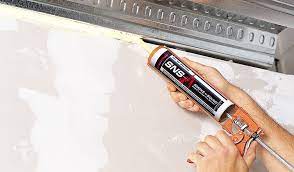Almost everyone is conversant in how soundproofing benefits their homes, offices, businesses, or any other property. If you are preparing to soundproof your property, you probably might have heard and done a lot of research on; The materials to use, how to apply them, and what works best
With the abundance of different kinds of caulk and sealants on the market it’s common to feel overwhelmed when choosing the right soundproof product for your construction or home improvement. Understanding what sets the acoustic caulk (sealant) and the regular caulk apart is a great place to start.
The major difference between acoustic caulk (sealant) and regular caulk is elasticity. Regular caulk is usually made from a mixture of latex and acrylic materials which makes them hardened and liable to shrink or crack when cured. On the other hand, acoustic caulk (sealant) offers greater elasticity and resistance to water because it contains silicone. The silicone material makes it easier for the sealant to expand and contract during temperature variations without losing its airtight or watertight seal.
You might have probably noticed that acoustic caulk (sealant) and regular caulk are mostly used interchangeably. This is because they both serve a similar purpose; acting as a sealing agent to fill up gaps and cracks and bonding agents between building materials like the seam between drywall panels or between your walls, ceilings, and ceiling. To help create a barrier against sound that enters your home through the cracks and gaps.
They are both applied on surfaces of soundproofing projects to block out sound transmission with or without using a caulking gun, this is the reason why the sealant is technically classified as a type of caulk.

Acoustic Caulk (Sealant) vs Regular Caulk
Acoustic sealant is very popular in soundproofing these days because of the advantages it has over regular caulk. Aside from the major differences between acoustic sealant and regular caulk. The acoustic caulk(sealant) is flexible and effective enough to fill up any cracks or gaps.
The main features of acoustic sealant are;
- Non-heading(it’s been made to stay flexible)
- It doesn’t shrinkage or crack
- It’s long-lasting
- Acoustic sealant can also operate as a vapor barrier.
On the other hand, regular caulking is hardened or non-flexible in quality, and due to this they usually have problems with cracks in the long run. This indicates that it is not strong enough to work as a durable sealant.
The cracks and shrinkage render the sealant useless and noise will pass through it easily without being blocked. This may ruin all the efforts you have in soundproofing your projects. However, if you want a permanent soundproofing solution, then the acoustic sealant is the best bet.
Another difference is the adhesive nature of the acoustic caulk and its ability to maintain its flexibility for a long period. Moreover, it also creates a strong barrier that protects it from soundproof leakage and also adheres firmly to any building material. Thus protecting the seams of your soundproof project from leakages. Due to its flexibility it can tightly stay connected to the materials or surface it is applied on without shrinking or cracking.
Acoustic caulk is usually rubber-like materials that do not harden when used to create sound barriers. The sealants are non-flammable, often latex-based, and are specifically made to reduce sound transmission through walls, rooms, and hard floors. The major benefits and differences that distinguish acoustic sealant from regular caulk are;
- Reduction in draft and sound transmission
- Ability to remain soft and pliable
- It’s constant or doesn’t change in shape.
What is Acoustic Caulk( Sealant) Used for?
As we have already mentioned, acoustic caulk sealant should be applied to gaps, cracks, and seams. So you need to figure out places where there is a joint between two materials such as the seam between the walls, floors, ceilings, and drywall panels. Use an acoustic caulk gun to fill up all those major gaps.
You can also use the sealant around your wiring boxes, windows, and doors. Besides it being effective at sealing electrical boxes and outlets it is also excellent for securing them as well as, it does this by protecting them from air and water
How to Use an Acoustic Sealant
The application is very simple regardless of the acoustic sealant you choose to use.
Prepare Your Room
First of all, you need to ensure that you are working in a well-ventilated room. Although the acoustic sealant doesn’t give out a pungent smell it does give an empowering smell. So you need to protect yourself.
Clean Up the Drywall for the Sealant to Adhere Better
Just ensure that the surface on which the sealant will be applied is clean as debris, dust, and dirt can interfere with the curing and elasticity of the work. Bear in mind that the cleaner the surface the better the sealant will adhere to it.
Cut Out the Nozzle of the Sealant
Cutting out the nozzle of the tube will help create a suitable hole. The size of the opening should be cut based on the width of the gap you are trying to fill up. Use a knife or scissors to cut out the tip nicely and smoothly. Moreover, most acoustic caulk comes along with a tip cutter built into the handle.
Use Acoustic to Apply the Sealant
The tube is very hard to squeeze. So it’s better to use the caulking gun for easy application. In case you don’t have one you purchase it at your local home improvement store.
Smooth Out the Beads with an Acoustic Tool
Finally, use one or two fingers to smooth over the beads, so that you can get a nice-looking surface. Bear in mind that the goal is to smooth out the caulk and not remove it.
Allow the Sealant to Dry
Give it about 48 hours for it to properly dry before you paint it.
Types of Acoustic Caulk (Sealant) and Regular Caulk
There are many types of acoustic caulk (sealant) and regular caulk for both inside and outside of your home. Here are a few types;
- Latex caulk
- Silicone sealant
- Polyurethane sealant
- Specialty caulks such as butyl-rubber caulk
Conclusion
Choosing the right material is essential for your indoor and outdoor projects as it has a huge impact on the longevity and efficiency of blocking noises in the long run. Choosing the acoustic caulk (sealant) is a smart choice especially if you live in an area where noise transmission through walls or rooms is a major concern. It is also suitable for places with weather fluctuations, and high moisture levels and can be applied around your windows and doors.
- How to Chew Quietly While Eating-Effective Tips - April 14, 2023
- Why is My Clutch Pedal Squeaking – Causes & Fixes - April 14, 2023
- Propane Tank Making Hissing Noise (Solved) - February 25, 2023

